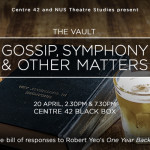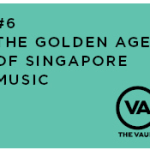With original English-language plays by the likes of Lim Chor Pee and Goh Poh Seng in the 1960s, it seemed like Singapore theatre was off to a promising start. But just a decade into Singapore’s independence, it was Goh that made the above statement calling time on the local theatre scene.
Perhaps rumours of Singapore theatre’s death in the 1970s had been greatly exaggerated. It’s only with the benefit of hindsight that arts writers like Clarissa Oon can call the decade as Singapore theatre “in transition”, especially with the “first golden age of Singapore theatre” just around the corner in the 80’s.
Here is a glimpse into how Singapore theatre was alive and kicking in the 1970s through three key trends of the decade.
-
Contrary to expectations and predictions, interest in drama did not collapse.Violet Oon
Early in the 1970s, the withdrawal of the British troops from Singapore spelt doom for a largely amateur and expatriate theatre scene. Stage clubs in military bases like Tengah and Nee Soon wound up as its British members and audiences left the island. In 1971, the Singapore Herald reported that local theatre enthusiasts were predicting Singapore theatre would “die a natural death in a year’s time”. Nancy Byramji for the Straits Times painted a mournful picture of “empty seats” in theatre houses.
But all was not lost. A year later, New Nation’s Violet Oon jauntily wrote, “Contrary to expectations and predictions, interest in drama did not collapse.” Oon pointed out that the void left behind by the British groups was in actual fact space for newer players to emerge, albeit inexperienced.
Active amateur theatre groups of the decade included the Stage Club and The Young Musician’s Society, alongside collectives started in the local university, like Experimental Theatre Club, University of Singapore Society and University of Singapore Drama Society. But while the 1970s in Singapore was marked by high economic growth rates and a newfound prosperity for the fledgling nation, these local theatre groups didn’t seem to be part of the success story, struggling for money, audiences, members, and even space.
Former members of these groups painted a bleak picture. In the Singapore theatre history publication Theatre Life!, Kate James said that Experimental Theatre Club could be performing to an audience of just 20 people, and Lim Kay Tong declared “there was no theatre scene” because productions were far and few between. “Turnover of membership is very high. Our problem is to get a core of members who will be there to keep the interest going,” said D. Murugan, president of the Experimental Theatre Club. Murugan also bemoaned the lack of rehearsal space, with his club wandering from one home of a “kind host” to another.
All these problems were pegged to an absent professional theatre industry. Donald Moore writing for New Nation was harsh in his critique of the Singapore English-language theatre scene at the time: “The Western theatre is the prisoner of its own inevitably amateur status, incapable of producing anything but mediocrity. With the best will in the world, little is possible in the theatre without long and arduous training, professionalism, and a modicum of genius.”
Yet, for all these problems, the amateur theatre groups of the 70’s soldiered on. Amy Chua for the Straits Times called these groups a “hardy lot” who were “self-supporting”, continuing the stage productions year on year out of passion for theatre.
-
As you write a play, you feel justice will not be done to your work – so you fight shy of writing it.Goh Poh Seng
Local theatre groups in the 1970s preferred to stage Western plays in the belief that local play-writing was both scarce and of low quality. This wasn’t an entirely grim situation. Clarissa Oon wrote, “Although the reliance on foreign plays set back the development of a Singaporean voice, the fact that these [Western] scripts tended to be well-crafted allowed homegrown directing and acting talent to shine.”
Still, a good full-length original Singapore play was an extreme rarity in this decade. Some locally-written short plays did make it to the stage during the decade, and on one occasion in 1972 were described as “show[ing] some promise”. But from the 70’s, only two stand-out full-length Singapore plays emerged.
The first was Robert Yeo’s Are You There, Singapore?, about a group of Singaporean students studying in London. Yeo was then a published poet and a first-time playwright. Are You There, Singapore? was staged by the University of Singapore Society in 1974 to full houses of local audiences. Reviewing Are You There, Singapore? for New Nation, Violet Oon was effulsive in her praise for the original work: “[I]t convinced me more than ever that Singaporeans should act in plays written by our own people because then we can identify with the ideas, moods and nuances. Double meanings can be understood and appreciated. This feeling seems to be shared by other people because it is about the best-attended play I’ve seen.”
Three years later, chemist Li Lien Fung would pen The Sword Has Two Edges based on The Romance of the Three Kingdoms, which, like Yeo, was her first full-length English script. Li’s play was staged by the Experimental Theatre Club in 1977 and achieved similar box office success. Oon called The Sword Has Two Edges “undoubtedly the best local play I’ve seen produced so far.”
These two works proved that there was an appetite for Singaporean plays. So why weren’t more full-length local works written during the decade? While Goh Poh Seng admitted that local writing wasn’t up to par, but he also pinned the blame on the amateur groups. “The frustrating thing is that there are no theatre groups in Singapore of any standing or standards at all,” he wrote in New Nation in 1976. “As you write a play, you feel justice will not be done to your work – so you fight shy of writing it. One is always accepting limitations – bad actors, amateur directors, no decent lighting and stage facilities, and so on.” Which should come first – good plays or good theatre groups? “It’s a vicious cycle,” declared Goh.
-
In 1977, the Ministry of Culture convened an advisory committee on drama comprising a number of theatremakers and chaired by Robert Yeo. A number of initiatives emerged from the recommendations of the committee to boost Singapore theatre-making and -going.
One of these initiatives was the Drama Promotion Scheme, a $2,000 grant for theatre groups to stage productions. The Business Times in January 1978 reported that the scheme carried two conditions: all profits from the production would go back to the Ministry, and ticket prices had to be kept low to encourage public attendance.
The advisory committee’s recommendations also spawned a nation-wide playwriting competition, as well as an annual Drama Festival. The inaugural Drama Festival was a two-week affair in August 1978 at the Victoria Theatre with 15 stage performances. The Ministry of Culture, which organised the festival, intended for the event to “raise the standard of drama performance and encourage appreciation of drama among Singaporean”. The Ministry later described the first Drama Festival as a “reasonable success [with] attendances averaging 60 per cent and above at most performances”.
Also of note was the first Singapore Festival of the Arts in 1977 – a precursor of today’s Singapore International Festival of Arts – organised by The Young Musicans’ Society. (The running of subsequent editions was taken over by the Ministry of Culture and its successors.) The Singapore Festival of the Arts provided yet another platform for theatre groups to create and stage work for local audiences.
But the 1970s was also a chilling time to be in theatre with cultural policing by the State. Some of it was relatively benign, like national policies barring foreign men with long hair from entering the country. Other measures were more restrictive – Ministry of Culture regulated and censored material for public consumption, including play scripts. For example, the University of Singapore Drama Society was banned from staging Yukio Mishima’s Madame de Sade in 1972 because the Ministry had deemed the script “unacceptable”. A performance permit for Yeo’s sophomore play One Year Back Home was also held back for over a year until sufficient revisions had been made to its overtly political content; the play was eventually permitted to be performed in 1980.
Perhaps most severe of all government interventions in the decade was the crackdown on political dissidents suspected of pro-communist activities. In the mid-1970s, alleged enemies of the state were detained without trial, including many local practitioners of Chinese theatre, which at the time was producing socially and politically charged works. Among the Chinese theatre practitioners detained were dramatist Kuo Pao Kun and his wife Goh Lay Kuan, founders of the Practice Theatre School (now The Theatre Practice). Koh and Goh were detained in 1976 and held for four-and-a-half years and six months respectively.
By Daniel Teo
Published on 19 April 2019
References
Business Times. (1978, January 23). Upturn for local drama. Downloaded from NewspaperSG.
Byramji, N. (1971, April 11). The empty seats that wait for the young ones to grow up. In Straits Times. Downloaded from NewspaperSG.
Chua, A. (1976, December 16). The cultural desert. In Straits Times. Downloaded from NewspaperSG.
Goh, P. S. (1976, October 1). Playwrights don’t use ordinary speech – that’s why they are a failure. In New Nation. Downloaded from NewspaperSG.
Lam, D. (1978, August 28). Ministry: First Drama Festival a success. In Straits Times. Downloaded from NewspaperSG.
Loon, R. (2016). Singapore English Theatre: Dynamic and diverse. In Singapore Chronicles: Theatre (pp. 17-41). Singapore: Institute of Policy Studies & Straits Times Press.
Moore, D. (1971, July 24). The state of the arts in Singapore. In New Nation. Downloaded from NewspaperSG.
New Nation. (1978, May 28). Focus on stage. Downloaded from NewspaperSG.
Oon, C. (2001). Theatre Life!: A history of English-language theatre in Singapore through The Straits Times (1958-2000). Singapore: Singapore Press Holdings.
Oon, V. (1972, January 8). A not-too-drastic drop in standards. In New Nation. Downloaded from NewspaperSG.
Oon, V. (1972, April 28). Local plays show some promise. In New Nation. Downloaded from NewspaperSG.
Oon. V. (1974, July 26). Bob’s play goes off like a shot. In New Nation. Downloaded from NewspaperSG.
Oon. V. (1977, August 26). Breathes life into history. In New Nation. Downloaded from NewspaperSG.
Singapore Herald. (1971, January 29). Local drama groups inactive. Downloaded from NewspaperSG.
Straits Times. (1972, December 9). Govt bans play to be staged by University Drama Society. Downloaded from NewspaperSG.
Straits Times. (1978, September 26). High turnover impeding steady growth of drama. Downloaded from NewspaperSG.






